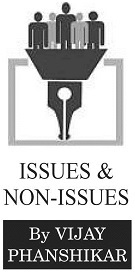The Shifting Paradigm
| Date :06-Jul-2019 |
Politics apart, the changing, shifting social paradigm is visible in almost all sectors of India’s public life. There may be a few undesirable changes taking place in this rush. Yet, the overall tone and tenor of the social change in India is a welcome development by any standard, by any definition.
Kolkata, July 4 (IANS): Newly-wed Trinamool Member of Parliament Nusrat Jahan, on Thursday, sought to send a strong message of secularism, faith and humanity when she attended the International Society for Krishna Consciousness (ISKCON) Rath Yatra event here.

Sporting a traditional look in a saree, ‘mangalsutra’, and bangles, the Bengali actress took part in all the rituals along with her husband Nikhil Jain and other dignitaries.
“I think I am blessed that God has given me this opportunity to stand on behalf of all young Indians who think the way I am thinking today. We stand for inclusive India, secularity, and humanity”, Nusrat told Reporters.
She said, she felt honoured to be invited by the ISKCON and is proud of the various religions and diverse culture where everyone comes together to celebrate the festivities.
COMING from Mrs. Nusrat Jahan Nikhil Jain, the young, beautiful and thoughtful Member of Parliament, the message has a tremendous impact on Indians of all age groups. Considering herself as a representative of young India, Mrs. Nusrat Jahan Jain was hugely successful in passing a genuine message of unity through diversity. Everybody adores her for that.
Easily, she can be considered as a true representative of the inclusive India she talked about, not allowing herself to be confined by religious or social dogma. Her idea was simple: Indian culture is truly diverse and inclusive, and she sought to symbolise that through her actual actions and not just political tall talk.
As she took oath as a Member of Parliament a few days ago, Mrs. Nusrat Jahan Jain endeared herself to the nation when she said Joy Bangla, Joy Hind, Vande Mataram (which many Muslims consider an anathema as not permitted by Islam). Instantly, she became everybody’s darling.
Mrs. Nusrat Jahan is right when she insists that young Indians stand for secularism and humanity. For, a vast majority of younger generations of Indian people -- particularly people under 35 years of age -- have an altogether different mindset that does not recognise barriers such as caste and creed. This welcome change has become increasingly visible in the past 4-5 years, so much so that all traditional calculations of electoral politics were proved wrong in the recent general election.
As speaker after speaker in the debate on Motion of Thanks to the President in Lok Sabha and Rajya Sabha talked about this changing trend, and damned those who still tried to cling to traditional calculations, Mrs. Nusrat Jahan went a step further not just by dressing traditionally, but also talking traditionally, almost shocking many. That her attire was a matter of attraction and adoration, was one thing. But what seemed to matter more was the manner in which Mrs. Nusrat Jahan gave out the three slogans at the end of her oath-taking.
And she was not alone in that. Her journeywoman Ms. Mimi Chakraborty also followed suit, came dressed in a traditional manner and held sway over everybody’s mind. It was only natural that the two young women were thronged by the media as they stepped out of the Parliament House. So thick was the media rush that both of them went back into the building, only to emerge much later to go home without much hassle.
What made the approach of the two women an event to remember was their attire a few days earlier. After they were declared elected, the two of them visited the Parliament Complex dressed in western style and took countless selfies against the iconic Parliament building. The media and the nation did not miss the contrast both women presented together on two different days. And the nation, too, got the message.
Both of them truly represent the young India that refuses to be daunted by caste and creed and dogma. In massive numbers, young people are emerging from their traditional cocoons to assert that they stand for an absolute inclusiveness beyond all physical barricades and socio-political as well as economic barriers. These young people also do not believe in artificial divisions the politically-driven Indian society maintained for long without sense. Mrs. Nusrat Jahan Jain and Ms. Mimi Chakraborty and many other young people in the new Lok Sabha stand for that India. They may still be distributed in different segments of political opinion, but they do represent an inclusive India in which artificial barriers are soon going to melt at a fast pace.
Unfortunately, there still are many people in senior political ranks of the so-called Left-Of-The-Centre ideological divide believing firmly on traditional cleavage of the society. In the past two general elections, the traditionalists were proved wrong in a big measure. And in the future years, their social rejection will be complete.
Unfortunately, these traditionalists do not seem to see the writing on the wall. They are in a denial mode, refusing to accept the socio-political change that is taking place in the country. They refuse to recognise the fact that the massive electoral mandate the Bharatiya Janata Party and its allies won is indicative of the change that has already got into a fast-forward motion.
Politics apart, the changing, shifting social paradigm is visible in almost all sectors of India’s public life. There may be a few undesirable changes taking place in this rush. Yet, the overall tone and tenor of the social change in India is a welcome development by any standard, by any definition. There are reasons to believe that in the immediate future, India will be subjected to a massive positive social change which the nation will never fail to welcome open-mindedly.